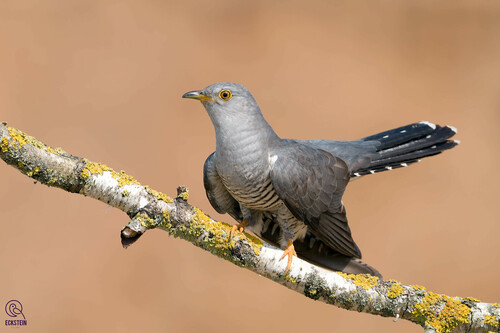
Common Cuckoo
The Common Cuckoo (*Cuculus canorus*) is a widespread and well-known bird, famous for its distinctive call and its brood parasitic behavior. It plays a significant ecological role by controlling insect populations, particularly caterpillars, which many other birds avoid. While common in many areas, its secretive nature often means it is heard more than seen. Culturally, the cuckoo's call is a traditional harbinger of spring across Europe and Asia.
32-34 cm
Length
55-65 cm
Wingspan
Least Concern
Conservation Status
Distribution
The Common Cuckoo has a broad distribution, breeding across Europe and Asia, and migrating to sub-Saharan Africa and parts of South Asia for the winter. It occupies a wide altitudinal range, from sea level to mountainous regions.
Lifespan
Typical lifespan in the wild is unknown but estimated at several years. Captive birds can live longer.
Common Cuckoo's Habitat
Habitat Types
Woodlands, Farmlands, Heathlands, Reedbeds, Moorlands
Climate Zones
Temperate, Boreal, Tropical (during migration/wintering)
Adaptations
The Common Cuckoo's migratory behavior is a key adaptation, allowing it to exploit seasonal food resources and avoid harsh winter conditions. Its brood parasitism also reduces the energetic cost of raising young.
Variations
Several subspecies are recognized, differing slightly in plumage and call. These variations are often subtle and require expert identification.
Appearance
Breeding Plumage
Adult males are typically greyish above with a barred breast. Females can be grey or rufous-brown. There is no significant seasonal change in plumage.
Seasonal Feather Changes
No significant seasonal variation
Sex Based Plumage Differences
Females exhibit polymorphism, occurring in both grey and rufous morphs.
Notable Features
Slender body shape, Long, pointed wings, Long, graduated tail, Slightly down-curved bill
Diet and Feeding
Primary Foods
Caterpillars, Insects, Beetles, Spiders
Foraging Behavior
The Common Cuckoo primarily forages in trees and shrubs, searching for insects. It often perches on branches and scans for prey.
Specializations
It is one of the few birds that readily consumes hairy caterpillars, which are toxic to many other species.
Seasonal Diet Variations
Diet varies depending on the availability of insects. During the breeding season, caterpillars form a major part of the diet.
Behavior
Social Structure
Generally solitary, except during brief pairings for mating.
Communication
Distinctive 'cuckoo' call of the male, Bubbling call of the female, Various chattering calls
Migration
Long-distance migrant, travelling between breeding grounds in Eurasia and wintering grounds in Africa. Migration is triggered by changes in day length and food availability.
Territorial or Group Behaviors
Males are territorial during the breeding season, defending their calling perches. Females have overlapping home ranges.
Conservation
Threats
Habitat loss, Decline in host species populations, Pesticide use (reducing insect prey), Climate change (affecting migration timing and host species breeding)
Protection Programs
Habitat restoration and protection, Monitoring of cuckoo and host populations, Research into the impacts of climate change
Local National Laws
Protected under various national and international wildlife laws, such as the EU Birds Directive.
Population Trend
Decreasing in some regions, particularly Western Europe, but stable or increasing in others.
Population Estimates
Global population estimated to be in the millions, but precise figures are difficult to obtain.
Interesting Facts
Cuckoo chicks eject host eggs or chicks from the nest
This ensures the cuckoo chick receives all the food provided by the host parents.
Females can mimic the calls of sparrowhawks
This may help to scare host birds away from their nests, allowing the cuckoo to lay its egg.
Different female cuckoos specialize in parasitizing different host species
Their eggs often closely mimic the eggs of their chosen host.
Faqs about Common Cuckoo
Why do cuckoos lay their eggs in other birds' nests?
This behavior, called brood parasitism, allows cuckoos to avoid the energy-intensive process of raising their own young. It also allows females to lay more eggs than they could if they had to care for them.
How does the cuckoo chick survive in a host nest?
The cuckoo chick often hatches earlier and grows faster than the host chicks. It ejects the host eggs or chicks, ensuring it receives all the food.
Do host birds ever recognize cuckoo eggs?
Some host species have evolved the ability to recognize and reject cuckoo eggs, leading to an evolutionary arms race between cuckoos and their hosts.
What should I do if I find a Cuckoo?
Admire it from a distance, and keep any pets away. It's best to avoid any interactions that could cause it stress.
Copyright @ Nature Style Limited. All Rights Reserved.
 English
English